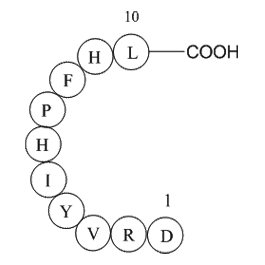Angiotensin I (human, mouse, rat) |
| Catalog No.GP10087 |
Products are for research use only. Not for human use. We do not sell to patients.

Cas No.: 484-42-4
Sample solution is provided at 25 µL, 10mM.
Angiotensin I (Ang I) (C62H89N17O14), with the sequence H-Asp-Arg-Val-Tyr-Ile-His-Pro-Phe-His-Leu-OH, is formed by the action of renin on angiotensinogen. Renin is produced in the kidneys in response to renal sympathetic activity, decreased intrarenal blood pressure (<90mmHg systolic blood pressure) at the juxtaglomerular cells. Ang I appears to have no biological activity and exists solely as a precursor to angiotensin II (A II). Ang I is cleaved to Ang II by the angiotensin-converting enzyme (ACE). Ang II increases blood pressure by stimulating the Gq protein in vascular smooth muscle cells (which in turn activates contraction by an IP3-dependent mechanism).
References:
1. Lundequist, A. et al. J. Biol. Chem. 279, 32339 (2004); Olson, S. et al. Am. J. Physiol. Lung. Cell Mol. Physiol. 287, L559 (2004); Sanker, S. et al. J. Biol. Chem. 272, 2963 (1997).
2. Preston RA, Materson BJ, Reda DJ, et al. Age-Race Subgroup Compared With Renin Profile as Predictors of Blood Pressure Response to Antihypertensive Therapy. JAMA. 1998;280(13):1168-1172. doi:10.1001/jama.280.13.1168.
Average Rating: 5 (Based on Reviews and 30 reference(s) in Google Scholar.)
GLPBIO products are for RESEARCH USE ONLY. Please make sure your review or question is research based.
Required fields are marked with *




















